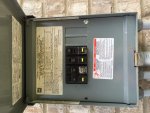Hello to All,
Wanted to determine if anyone has learned of successful way to suppress electrical surges that could negatively impact a VSP?
My current set-up are two 200amp services in my garage, to where a 70amp breaker comes off one of them to supply current to my pool controller. The pool controller then has 6 breakers that service the various devices. Specifically, a Sq-D double pole 20amp GCFI breaker provide the sole power to my Hayward SP3400VSP. My PS-8 controller has no more breaker slots.
So, I was seeking advice from those that have had a successful campaign in protecting their VSP from electrical surges/spikes. Also, all my equipment is under warranty from Hayward for a period of 3 yrs; install date is Jan 2015.
Thank you for your feedback.
Regards,
tstex
Wanted to determine if anyone has learned of successful way to suppress electrical surges that could negatively impact a VSP?
My current set-up are two 200amp services in my garage, to where a 70amp breaker comes off one of them to supply current to my pool controller. The pool controller then has 6 breakers that service the various devices. Specifically, a Sq-D double pole 20amp GCFI breaker provide the sole power to my Hayward SP3400VSP. My PS-8 controller has no more breaker slots.
So, I was seeking advice from those that have had a successful campaign in protecting their VSP from electrical surges/spikes. Also, all my equipment is under warranty from Hayward for a period of 3 yrs; install date is Jan 2015.
Thank you for your feedback.
Regards,
tstex


